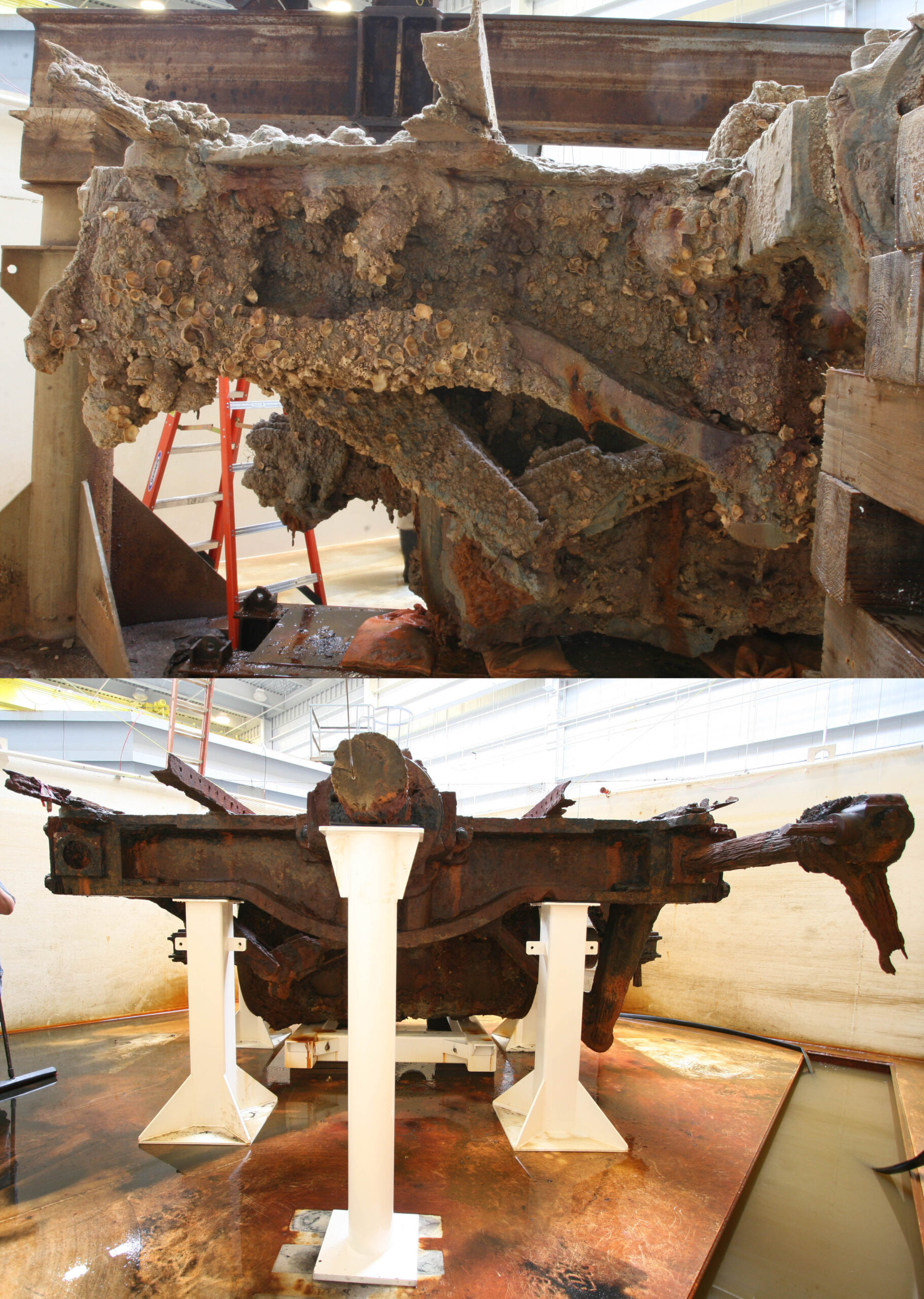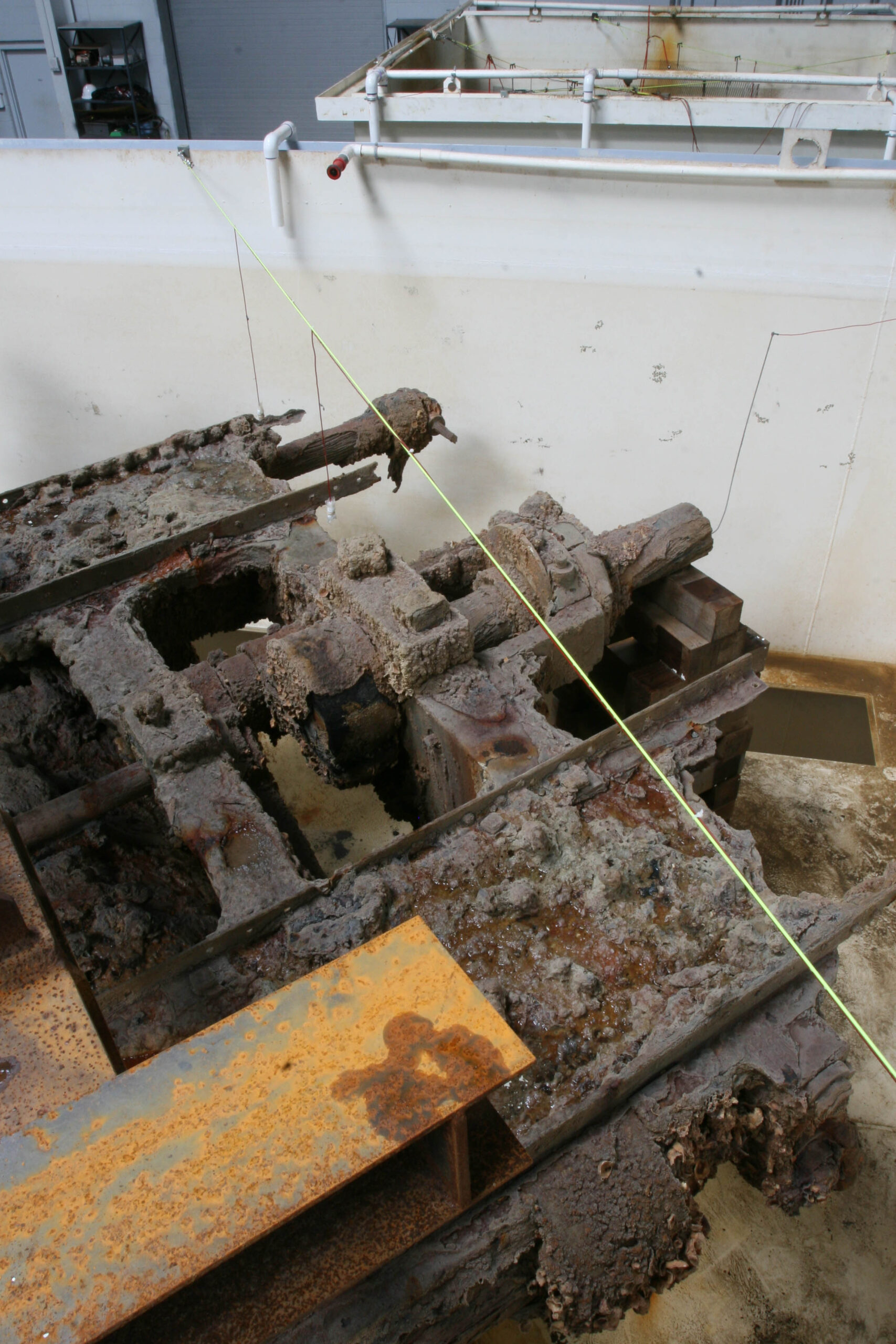This past week the 30,000 gallon tank containing Monitor’s steam engine was drained for a key milestone in the conservation of this unique artifact. The purpose for the tank drain was the installation of a new support system under the engine that will enable the eventual disassembly of the object. Up to this week, the engine which weighs approximately 25 tons, had been suspended off the ground from a massive I-bean supported on large steel posts. In the images below, you can see the engine before and after recent deconcretion efforts suspended from the I-beam.

To connect the engine to the beam, steel frames with shackles passed though the engine bed up to the beam. In the images below, you can see one shackle and corresponding support frame as well as the hole cut through the engine bed to enable the mounting system to function. The hole was cut into the engine bed by Navy divers 230 feet underwater at the wreck site, which at that time was the best method for removal from the seafloor.

As treatment on the engine progressed over the last year, it became clear that before any large-scale disassembly of the object could commence, a more structurally-sound support had to be installed. The reasons for this were safety concerns for both staff and object, and to create a strong level mount from which components could more easily be removed from the engine. So, over the past several months Gary designed and fabricated new support posts to be placed under the propeller shaft, four corners of the engine bed, steam cylinder, and valve chests. In the following pictures you can see the cylinder/valve chest) support frame being put into place. (Dave in first, Will and Dave in second)

Support being jacked into place under the engine

Once the cylinder/valve chest frame was installed, we placed two supports beneath the back of the engine bed. To do this, we had to pick up the propeller shaft with the crane, slide the new posts into place, and then lower the engine down onto the posts. In the photo below you can see the white support posts under the engine bed with the crane hoist lowering the back of the engine onto posts.

With the rear of the engine on its mounts, now it came time to place the new supports at the front of the artifact. To do this, each end of the massive I-beam was carefully lifted (one side at a time) slightly elevating one of the front corners of the engine to allow the new mounting posts to be placed. In the pictures below you can see Will, Dave, and Gary placing the new front post on the port side of the engine. The red arrow in the picture points to the distance the beam was lifted, while the green arrow points the new support post.

Now that the support system for the entire weight of the engine had been shifted from above to below the engine bed, it came time to remove the I-beam. To do this, the beam was connected to one of the 20 ton crane hoists and the shackles were undone and the corresponding original support frames were carefully removed from under the engine bed. With the beam disconnected from the engine, it was lifted up and out of the tank. In the pictures below, the red arrow points to one of the removed support frames while the green arrow points to one of the tow lines which helped to keep the massive beam from swinging while we moved it across the lab.


Once the beam was away from the engine tank, we moved it across the lab and Gary used the heavy duty forklift to carry it out of the building.

After the I-beam was removed from the tank and lab, we then removed the original beam support posts. You can see one of the posts being taken out of the tank below as well as a fantastic photo of Gary, Will, and Dave.


The last step in the process was to place a new support under the propeller shaft, and after that, the engine was fully re-supported !!!!!!! The next couple of pictures show views of the starboard, port, aft, and bottom sides of the engine before deconcretion and after the beam’s removal.
Starboard side

Aft

Port side

Bottom


Now that the engine is on its new supports, its looks more like it did deep inside the hull of the Monitor. So, I thought it would be neat to throw up a drawing of Monitor’s engine next to an inverted photo of the actual engine for comparison!!! Enjoy!

Keep coming back to our blog for more Monitor conservation updates!!!!!!!!